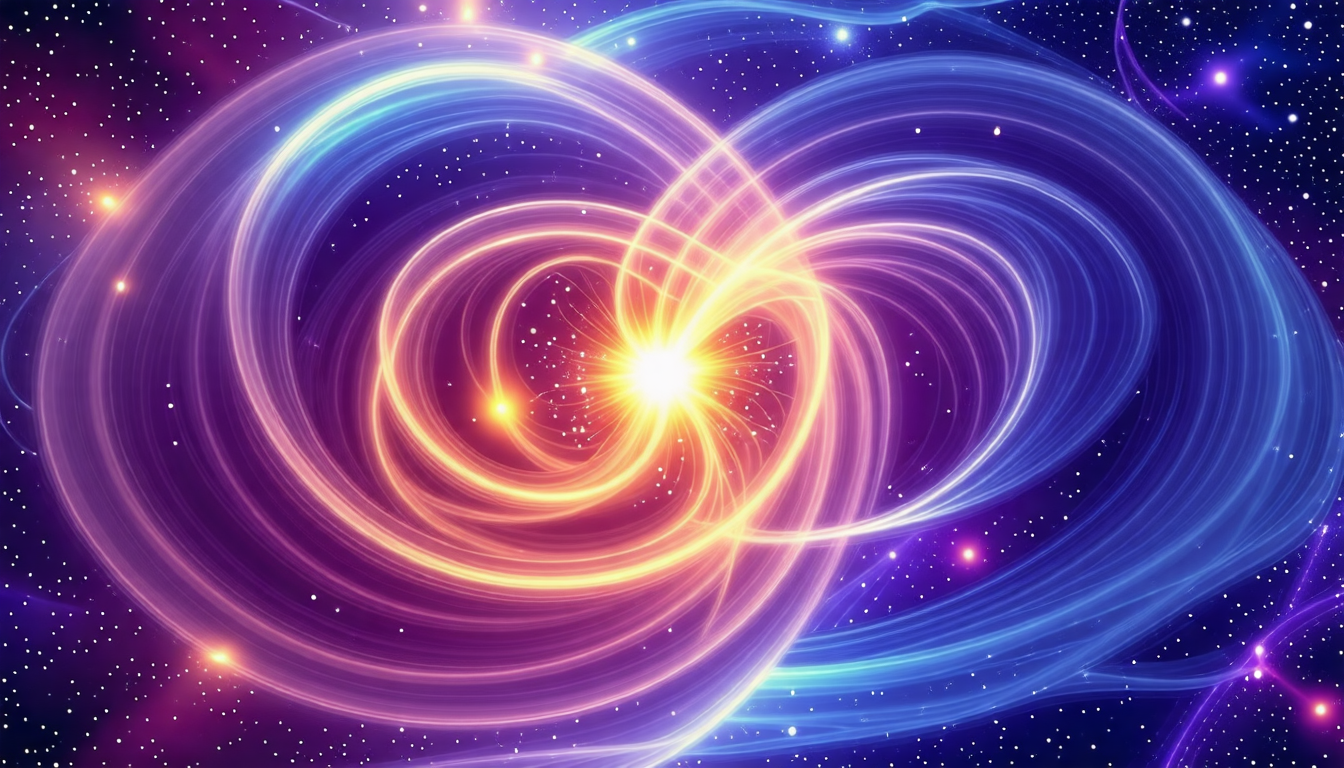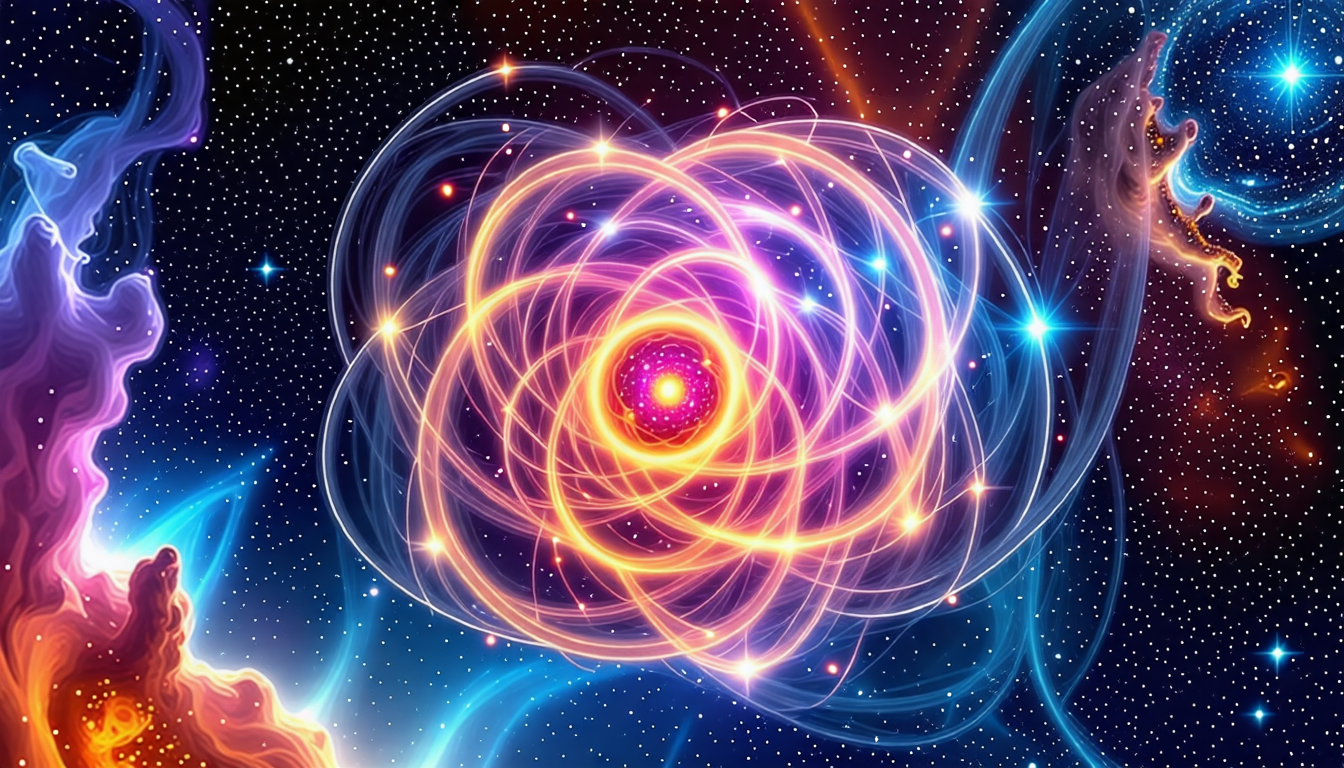The Cosmic Dance of Atoms and Their Role in Existence

The Origin and Structure of Atoms
Atoms, the fundamental building blocks of matter, arise from a fascinating interplay of forces and particles that are rooted deep within the fabric of the universe. To understand atoms, it’s essential to recognize their basic structure, which consists of a nucleus, made up of protons and neutrons, and a cloud of electrons that orbit this central core. The protons, defined by their positive electrical charge, dictate the element’s identity, while neutrons contribute to its mass without carrying an electric charge. Surrounding this nucleus, electrons exist in distinct energy levels or shells, held in place by electromagnetic forces that counterbalance the positive charge of the protons in the nucleus. Each atom’s behavior and interactions are primarily determined by the arrangement of these electrons, specifically those in the outermost shell, creating a rich tapestry of chemical reactivity and bonding possibilities.
The journey to understanding how atoms originate begins with an exploration of the early universe. Following the Big Bang, approximately 13.8 billion years ago, the universe was an extraordinary expanse of highly energetic particles. As it began to cool, conditions became viable for protons and neutrons—the building blocks of atomic nuclei—to come into existence. This initial formation occurred through a process called nucleosynthesis within the first few moments post-Big Bang, where the energy densities allowed for the creation of lighter elements, primarily hydrogen and helium, establishing the basis for all that would follow.
As the universe expanded and cooled further, neutral atoms eventually formed through the binding of electrons to these nuclei, marking a pivotal moment known as “recombination.” The creation of stable atoms allowed for the universe to transition from an opaque mass of energy to a less dense, transparent entity that could now facilitate the formation of stars and galaxies. The first stars ignited when these hydrogen and helium atoms clumped together under gravity, leading to nuclear fusion processes that transformed lighter elements into heavier ones, thus enriching the cosmos with diverse atomic structures.
Examining these early atomic formations unveils not only the nature of the universe but also the exquisite balance necessary for the synthesis and stability of matter. Each of the electromagnetic force, strong nuclear force, and weak nuclear force plays a role in binding subatomic particles—protons, neutrons, and electrons—together into stable atomic configurations. The strong nuclear force, in particular, holds protons and neutrons in the nucleus, overcoming the electromagnetic repulsion between the positively charged protons. However, this powerful force operates only at incredibly short distances, a feature vital to ensuring the integrity of atomic nuclei.
An intriguing aspect of atomic structure is the idea of isotopes—variant forms of an atom that possess the same number of protons but differ in the number of neutrons. This variability can influence the stability and mass of elements, leading to unique traits, such as radioactive decay in certain isotopes, which is governed primarily by the weak nuclear force. The existence of isotopes has vast implications across various scientific fields, illustrating the complexity and intricacies entwined in atomic structures and their roles within the larger cosmic framework.
As research into atoms and their structures continues to evolve, scientists have developed an array of cutting-edge technologies that allow for deeper exploration at atomic and subatomic levels. High-resolution imaging techniques, such as scanning tunneling microscopy and atomic force microscopy, now permit researchers to visualize individual atoms and understand their arrangements in materials. These advancements are essential in various fields, including materials science, nanotechnology, and chemistry, fostering innovations that reshape our understanding and application of atomic principles.
Ultimately, the origin and structure of atoms are not merely static concepts confined to the realm of theoretical science. They are dynamic, integral components of the universe’s grand story, contributing to everything from the formation of celestial bodies to the development of complex life. The more we delve into the atomic realm, the more we unveil the interconnectedness of forces that govern existence itself, revealing an intricate dance between energy and matter that defines the cosmos.

The Role of Quantum Mechanics in Atomic Formation
The advent of quantum mechanics marks a revolutionary chapter in our comprehension of atomic structure and formation. This branch of physics delves into the principles governing the behavior of subatomic particles, shedding light on the nature of electrons, protons, and neutrons through a lens that transcends classical physics. At the heart of quantum mechanics lies the principle of uncertainty, articulated by Werner Heisenberg, which will reshape our understanding of how and why atoms are formed.
In essence, quantum mechanics posits that particles do not have definitive positions or velocities; instead, their properties exist within the realm of probability. That’s particularly evident in the behavior of electrons, which, rather than revolving around the nucleus in fixed orbits akin to planets around the sun, inhabit defined regions of space described as orbitals. Each orbital represents areas where electrons are most likely to be found, distributed according to energy levels. This probabilistic distribution contributes significantly to the atomic structure, influencing how electrons engage in bonding processes with other atoms.
One of the key developments in quantum mechanics is the introduction of the electron cloud model. This model articulates that electrons exist in a ‘cloud’ around the nucleus, where the density of the cloud reflects the likelihood of an electron’s presence in a particular area. Such a model overturns previous notions of fixed paths, offering a more accurate depiction of atomic behavior. This understanding underpins the very nature of chemical bonding—atoms seek stability by forming bonds through electron sharing or transfer, a process heavily influenced by their respective electronegativity and the arrangement of valence electrons.
Moreover, the implications of quantum mechanics extend to the concept of entanglement—a phenomenon in which pairs of particles become linked in such a way that the state of one immediately influences the state of the other, regardless of the distance separating them. This intricate connection challenges our conventional understanding of reality, introducing questions about the fundamental interconnections between particles. It further enriches our understanding of how particles, once formed, can interact across vast distances as components of the universe.
The exploration of quantum phenomena not only broadens our understanding of atomic formation but also impacts fields ranging from materials science to chemistry, where the principles derived from quantum mechanics can guide the development of new materials and technologies. For instance, semiconductors—essential components in contemporary electronic devices—are engineered based on the behavior of atoms as predicted by quantum mechanical principles. By understanding how atoms bond and interact, scientists can tailor materials to fulfill specific functions, leading to innovations that optimize performance and efficiency in various applications.
Central to the atomic formation is also the role of quantum fluctuations, which refer to the seemingly spontaneous generation of particles from what we traditionally regard as a vacuum. In this fleeting state, particles can emerge from the fabric of spacetime, hinting at the dynamic nature of the universe itself. These fluctuations may have played an important role in the early universe by contributing to the formation of primordial atoms, such as hydrogen and helium, in those initial moments after the Big Bang, establishing the very foundation for all matter. Through understanding these principles, researchers can better comprehend the genesis of atomic structure and the subsequent evolution of the cosmos.
As we navigate through the principles of quantum mechanics, it becomes increasingly evident that our exploration of atoms is not merely a pursuit of isolated knowledge. Instead, it’s a journey into understanding the fundamental building blocks of our universe—each atomic interaction a note in the larger symphony of cosmic existence. This convergence of ideas showcases how the realm of quantum mechanics not only enhances our grasp of atomic formation but also unravels the elaborate tapestry interwoven through the fabric of reality, eternally connecting the microscopic with the vastness of the cosmos.

Stellar Processes and the Creation of Heavier Elements
The processes occurring within stars are the very forge of heavier elements, shaping the atomic makeup of the universe. At the core of these cosmic giants, conditions of unparalleled intensity—extreme temperatures and pressure—facilitate nuclear fusion, a reaction where light atomic nuclei, primarily hydrogen, merge to form heavier nuclei like helium. This not only releases a prodigious amount of energy, a phenomenon responsible for the radiant light we observe from stars, but it also sets off a chain reaction that enables the synthesis of even heavier elements as a star evolves.
As stars progress through their life cycles, they exhaust their primary fuel, typically hydrogen, transitioning to the fusion of helium into heavier elements such as carbon and oxygen in a process called stellar nucleosynthesis. This sequence is critical; during the life of a star, helium accumulates and, under sufficient pressure and temperature, fuses into heavier elements like neon, magnesium, and eventually elements as heavy as iron. Iron, the endpoint of fusion in normal stellar environments, represents a unique threshold: while lighter elements release energy when fused, fusion beyond iron absorbs energy, leading to an eventual cooling and collapse of the star.
In massive stars, as they evolve into supergiants, their cores become increasingly dense, fostering the conditions necessary for the formation of even heavier elements. Processes such as the triple-alpha process allow three helium nuclei to combine to form carbon, while further fusion reactions, including the S-process (slow neutron capture) and R-process (rapid neutron capture), can produce heavier elements like gold and uranium. These reactions rely significantly on the interplay between neutrons and protons, with the strong nuclear force maintaining the integrity of the increasingly complex nuclei formed during these stages.
A pivotal moment in the life cycle of massive stars occurs when they can no longer sustain fusion reactions that balance gravitational collapse. Upon exhausting their nuclear fuel, these stars undergo cataclysmic events known as supernova explosions. Such explosive phenomena are not merely a spectacle but serve an important role in the dispersal of the heavy elements synthesized within the star into the interstellar medium. This enriched gas and dust disseminate across galaxies, seeding new star systems, potentially giving rise to planets and, with them, the conditions suitable for life.
The aftermath of supernovae demonstrates the cyclical nature of cosmic evolution, emphasizing the role of stellar processes in the creation and distribution of elements throughout the universe. Elements forged in the hearts of these massive stars become the building blocks for the next generation of cosmic structures, illustrating a profound interconnectedness entwined within the fabric of existence itself.
The contributions of fusion processes to the universe extend beyond the mere creation of heavier elements—they embody the gravitational and nuclear forces that shape the cosmos. The matter generated within stars forms the foundation for galaxies, fostering an environment that allows for the second generation of stars and the potential for diverse planetary systems, including those capable of sustaining life. Understanding these processes provides key insight into the intricate interconnectedness of atomic structures, stellar formations, and the complex web of cosmic evolution.
This remarkable narrative of star life culminates in the assertion that atoms, the very essence of matter, are products of stellar alchemy. They embody the remnants of star death and life, a beautiful tapestry woven from the suffocating pressure and burning heat of stellar interiors, irradiating the universe in a cycle of birth and rebirth. The understanding of how these atoms came to be—through stellar processes—reveals why they are equipped with distinct properties and behaviors, forming the foundational building blocks of everything from the planet we inhabit to the stars that light our night skies.
Implications of Atomic Interactions for the Universe and Life
The intricate dance of atomic interactions fundamentally shapes the universe and life as we know it. At the most basic level, the interactions between atoms dictate the formation of molecules, which in turn underpin every aspect of the physical and biological worlds. The astounding variety of matter results from the unique combinations of atoms and the complex relationships they establish with one another. For instance, the diverse chemical behaviors observed in life-sustaining processes—from the metabolism of nutrients to the genetic coding of traits—stem directly from the ways in which atoms bond and interact.
In understanding the implications of atomic interactions, we confront the remarkable fact that the same basic principles govern both the cosmos and the intricacies of life on Earth. When we think the synthesis of complex organic molecules that constitute living organisms, we see the harmonious orchestration of atomic interactions. Carbon, often termed the building block of life, can form stable bonds with many elements, including hydrogen, oxygen, and nitrogen, creating a multitude of organic compounds. This versatility in bonding is made possible through the arrangement of valence electrons, allowing carbon to act as a central atom in various biochemical pathways. Ultimately, the interplay of these atomic interactions enables the formation of proteins, nucleic acids, and carbohydrates, the very essence of biological life.
The influence of atomic interactions extends beyond chemistry into the realm of physics, driving the evolutionary processes that shape galaxies and solar systems. The interconnectedness of atoms and molecular structures operates hand-in-hand with gravitational forces at the cosmic scale. When stars form from clouds of hydrogen and helium, the intricate gravitational attraction serves to gather more atoms, leading to the combustive phenomena that ignite stars. In this way, the fundamental processes of atomic interactions are mirrored in the grand cycles of stellar birth, life, and death, which foster an environment rich in the elements necessary for life.
Beyond the immediate implications for planetary systems, the interactions of atoms have resonating effects that shape Earth’s environment. For example, the properties of water—an exceptional solvent central to biological processes—arise from the polar covalent bonds between its constituent atoms. This molecular structure directly influences the unique behaviors of water, such as its high specific heat and solvent properties that support marine life and weather patterns. The way water molecules interact with each other exemplifies how atomic interactions create conditions essential for life to emerge and thrive.
The implications of atomic interactions further extend into the realm of technology. The emergence of novel materials engineered through precise atomic arrangements showcases the potential to revolutionize fields from medicine to energy. In nanotechnology, manipulating atoms allows for the development of new drug delivery systems, more efficient solar cells, and better batteries—each tailored to optimize their energy interactions. These advancements depend largely on our understanding of the fundamental principles governing atomic bonds and the behavior of matter, revealing just how critical atomic interactions are in shaping the future of human innovation.
Moreover, as scientists delve deeper into the atomic realm, they explore the potential for synthesizing new elements or materials, thereby unlocking further mysteries of the universe. Understanding how atomic interactions occur under different conditions may lead to breakthroughs in fields ranging from superconductivity to quantum computing. Thus, the exploration of atomic interactions serves not only as a scientific endeavor but as a bridge to unlocking practical solutions to some of humanity’s most pressing challenges.
The implications of atomic interactions intricate weave through the fabric of both the cosmos and life on Earth. By comprehending the fundamental principles governing these interactions, we gain invaluable insights into the mechanisms that shape everything from the stars above us to the biology of our very own bodies. As our knowledge expands, so too does our understanding of our place in the universe, revealing the interconnectedness of all matter in an intricate dance that spans the vastness of time and space.